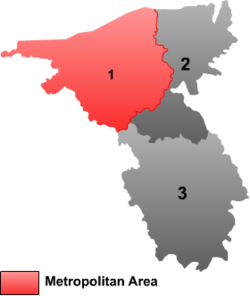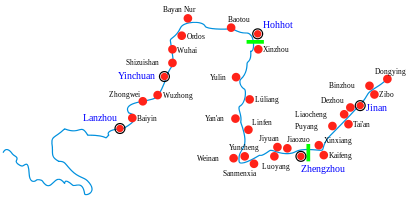Zhongwei
Zhongwei .mw-parser-output .nobold{font-weight:normal} 中卫市 · .mw-parser-output .script-arabic,.mw-parser-output .script-Arab{font-family:Scheherazade,Lateef,LateefGR,Amiri,"Noto Naskh Arabic","Droid Arabic Naskh",Harmattan,"Arabic Typesetting","Traditional Arabic","Simplified Arabic","Times New Roman",Arial,"Sakkal Majalla","Microsoft Uighur",Calibri,"Microsoft Sans Serif","Segoe UI",serif,sans-serif;font-weight:normal} ﺟْﻮوِ شِ | |
|---|---|
Prefecture-level city | |
 Wolfberry fields in Zhongning County, Zhongwei City | |
 Zhongwei in Ningxia | |
| Coordinates: 37°30′36″N 105°10′48″E / 37.51000°N 105.18000°E / 37.51000; 105.18000Coordinates: 37°30′36″N 105°10′48″E / 37.51000°N 105.18000°E / 37.51000; 105.18000 | |
| Country | People's Republic of China |
| Region | Ningxia |
| Municipal seat | Shapotou |
| Area | |
| • Total | 16,986.1 km2 (6,558.4 sq mi) |
| Population | |
| • Total | 1,041,821 |
| • Density | 61/km2 (160/sq mi) |
| Time zone | UTC+8 (China Standard) |
| Postal code | 755000 |
| Area code(s) | 0955 |
| ISO 3166 code | CN-NX-05 |
| Website | nxzw.gov.cn |
Zhongwei (simplified Chinese: 中卫; traditional Chinese: 中衛; pinyin: Zhōngwèi; Wade–Giles: Chung-wei; literally: "middle guard") is a prefecture-level city of Ningxia, People's Republic of China.
It has an area of 16,986.1 km2 (6,558.4 sq mi) and a population of 1,041,821.[1]
Contents
1 Tourism
2 Administrative divisions
3 Transportation
4 Photo gallery
5 See also
6 References
7 External links
Tourism
Zhongwei's main attraction is Gao Miao, a temple that has hosted Confucian, Buddhist, and Taoist ceremonies. A bomb shelter was also built beneath the temple during the Cultural Revolution. It has since been converted into a rendition of a Buddhist hell.[2] The prefecture is also the location of the beginning of the northern bend in the Yellow River that produces the Ordos Loop.
The world's largest photovoltaic power station, Tengger Desert Solar Park, is located in Zhongwei.[3]
Administrative divisions
| Map | |||||||
|---|---|---|---|---|---|---|---|
 | |||||||
| # | Name | Hanzi | Hanyu Pinyin | Xiao'erjing | Population (2003 est.) | Area (km²) | Density (/km²) |
| 1 | Shapotou District | 沙坡头区 | Shāpōtóu Qū | ﺷَﺎپُتِﻮْ ﺛُﻮْ | 350,000 | 4,633 | 76 |
| 2 | Zhongning County | 中宁县 | Zhōngníng Xiàn | ﺟْﻮنٍ ﺷِﯿًﺎ | 410,000 | 2,841 | 144 |
| 3 | Haiyuan County | 海原县 | Hǎiyuán Xiàn | هَیْیُوًا ﺷِﯿًﺎ | 380,000 | 6,979 | 54 |
Transportation

Zhongwei Railway Station in December 2015
- Zhongwei Shapotou Airport
- Baotou–Lanzhou Railway
Baoji–Zhongwei Railway, to points south (connections to Xi'an, Chengdu)
Taiyuan-Zhongwei-Yinchuan Railway, to points east (connection to Beijing)
Gantang–Wuwei Railway, to western Gansu and points west- Zhongwei–Lanzhou high-speed railway
Photo gallery

Desert Lake

Desert Lake

Desert Lake

Shapotou scenic area

Camels in Shapotou

Zhongwei cultural centre
See also
- Haiyuan County
- 1920 Haiyuan earthquake
- Zhongwei-Tongxin fault
References
^ (in Chinese) Profile of Zhongwei, visited on May 31, 2008.
^
Harper, Damian; Fallon, Steve; Gaskell, Katja; Grundvig, Julie; Heller, Carolyn; Huhta, Thomas; Mayhew, Bradley (2005). China (9th ed.). Lonely Planet. p. 980. ISBN 978-1-74059-687-9. OCLC 61143558..mw-parser-output cite.citation{font-style:inherit}.mw-parser-output .citation q{quotes:"""""""'""'"}.mw-parser-output .citation .cs1-lock-free a{background:url("//upload.wikimedia.org/wikipedia/commons/thumb/6/65/Lock-green.svg/9px-Lock-green.svg.png")no-repeat;background-position:right .1em center}.mw-parser-output .citation .cs1-lock-limited a,.mw-parser-output .citation .cs1-lock-registration a{background:url("//upload.wikimedia.org/wikipedia/commons/thumb/d/d6/Lock-gray-alt-2.svg/9px-Lock-gray-alt-2.svg.png")no-repeat;background-position:right .1em center}.mw-parser-output .citation .cs1-lock-subscription a{background:url("//upload.wikimedia.org/wikipedia/commons/thumb/a/aa/Lock-red-alt-2.svg/9px-Lock-red-alt-2.svg.png")no-repeat;background-position:right .1em center}.mw-parser-output .cs1-subscription,.mw-parser-output .cs1-registration{color:#555}.mw-parser-output .cs1-subscription span,.mw-parser-output .cs1-registration span{border-bottom:1px dotted;cursor:help}.mw-parser-output .cs1-ws-icon a{background:url("//upload.wikimedia.org/wikipedia/commons/thumb/4/4c/Wikisource-logo.svg/12px-Wikisource-logo.svg.png")no-repeat;background-position:right .1em center}.mw-parser-output code.cs1-code{color:inherit;background:inherit;border:inherit;padding:inherit}.mw-parser-output .cs1-hidden-error{display:none;font-size:100%}.mw-parser-output .cs1-visible-error{font-size:100%}.mw-parser-output .cs1-maint{display:none;color:#33aa33;margin-left:0.3em}.mw-parser-output .cs1-subscription,.mw-parser-output .cs1-registration,.mw-parser-output .cs1-format{font-size:95%}.mw-parser-output .cs1-kern-left,.mw-parser-output .cs1-kern-wl-left{padding-left:0.2em}.mw-parser-output .cs1-kern-right,.mw-parser-output .cs1-kern-wl-right{padding-right:0.2em}
^ "10 really cool Solar Power installations in (and above) the world". 29 January 2018. Retrieved 10 May 2018.
External links
- Official website of Zhongwei Government






